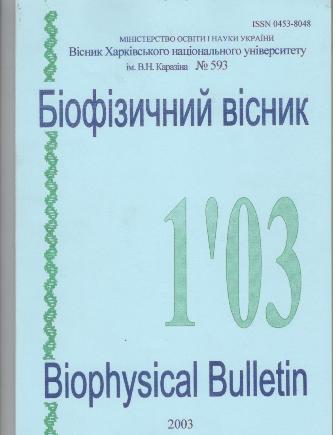Molecular dynamics simulation of the physical mechanisms of the interaction of caffeine and actinocin derivatines with DNA. The role of different factors in DNA-ligand complex formation
Abstract
Molecular dynamic simulation of the complex of caffeine and the new actinocin derivative with different DNA fragments has been carried out. The molecular models of caffeine and AcII intercalating in GC-site of oligonucleotide d(AGTC)2 and of outside drug binding in the minor groove of oligonucleotide d(GATAC)2 have been obtained. Energetic and structural characteristics of investigated systems have been also defined. It was shown that complexes of actinocin derivative with DNA are more structural and energetic preferable than DNA-caffeine complexes. The analysis of the changes in the first hydration shells of interactive components after their complexation has been carried out. It has been found that the degree of destruction of the monohydrated shell of DNA double-helix after complexation is determined by the mode of ligand binding, its possibility to make the hydration bonds with water molecules and depends a little on linear sizes of ligands.
Downloads
References
Maleev VYa, Semenov MA, Gasan AI, Kashpur VA. Biofizika. 1993;38(5):768-90. (in Russian).
Woda J, Schneider B, Patel K, Mistry K, Berman HM. Biophys J. 1998;75(5):2170-7.
Auffinger P, Westhof E. In: Ross YH, Leslie RB, Lillford PJ, editors. Water management in the design and distribution of quality foods. Basel:Technomic Pulishing Co Inc; 1999. p. 165-198.
Warters RL, Lyons BW, Kennedy K, Li TM. Mutat Res. 1989;6(1):43-55.
Jafari M, Rabbani A. Toxicology. 2000;149(2-3):101-8.
Deplanque G, Vincent F, Mah-Becherel MC, Cazenave JP, Bergerat JP, Klein-Soyer C et al. Cancer. 2000;83(3):346-53.
Stockert JC. Acta Histochem. 1989;87(1):33-42.
Bedher E, Du L, Traganos F, Darzynkiewicz Z. Cytomery. 2001;43(1):38-45.
Veselkov DA, Kodintcev VV, Pakhomov VI, Dymant LN, Devis DB, Veselkov AN. Biofizika. 2000;45(2):193-201. (in Russian).
Wadkins RM, Vladu B, Tung Ch-Sh. Biochemistry. 1998;37:11915-23.
Glibin EN. Synthesis of phenoxazone drugs. In: Veselkov AN, Davies DB, editors. Anti-Cancer drug design. Sevastopol:SEVNTU PRESS;2002. p.23-30.
Cornell WD, Cieplak P, Bayly CI. J Amer Chem Soc. 1995;117:5179.
Jorgensen WL, Chandrasekhas J, Madura JD, Impey RW, Klein ML. J Chem Phys. 1983;79:926-35.
Naberukhin IuI. Zhurn Struktur Khimii.1984;25:60-7. (In Russian).
Malenkov GG, Tytik DL, Zheligovskaya EA. J Mol Liquids. 1999;82:27-38.
Anishchenko DB, Berezniak EG, Shestopalova AV, Maleev VIa. Biofizicheskii vesnik. 2002;560:36-41. (in Russian).
Schmidt MW, Baldrige KK, Boatz JA. J Comput Chem. 1993;14:1347-63.
Wang J, Wang W, Huo S, Lee M, Kollman PA. J Phys Chem. 2001;105:5055-67.
Bodor N, Gabanyi Z, Wong C. J Am Chem Soc. 1989;111:3783.
Baginski M, Polucci P, Antonini I, Martelli S. J Mol Model. 2002;8:24-32.
Tao NJ, Lindsay SM, Rupprecht A. Biopolymers. 1988;27:1655-71.
Tao NJ, Lindsay SM, Rupprecht A. Biopolymers. 1989;28:1019-30.
Semenov MA, Bereznyak EG. J Comments on Mol Cell Biophys. 2000;1:1-23/
Qu X, Chaires JB. J Am Chem Soc. 1999;121:2649-50.
Qu X, Chaires JB. J Am Chem Soc. 2001;123:1-7.
Authors who publish with this journal agree to the following terms:
- Authors retain copyright and grant the journal right of first publication with the work simultaneously licensed under a Creative Commons Attribution License that allows others to share the work with an acknowledgement of the work's authorship and initial publication in this journal.
- Authors are able to enter into separate, additional contractual arrangements for the non-exclusive distribution of the journal's published version of the work (e.g., post it to an institutional repository or publish it in a book), with an acknowledgement of its initial publication in this journal.
- Authors are permitted and encouraged to post their work online (e.g., in institutional repositories or on their website) prior to and during the submission process, as it can lead to productive exchanges, as well as earlier and greater citation of published work (See The Effect of Open Access).





